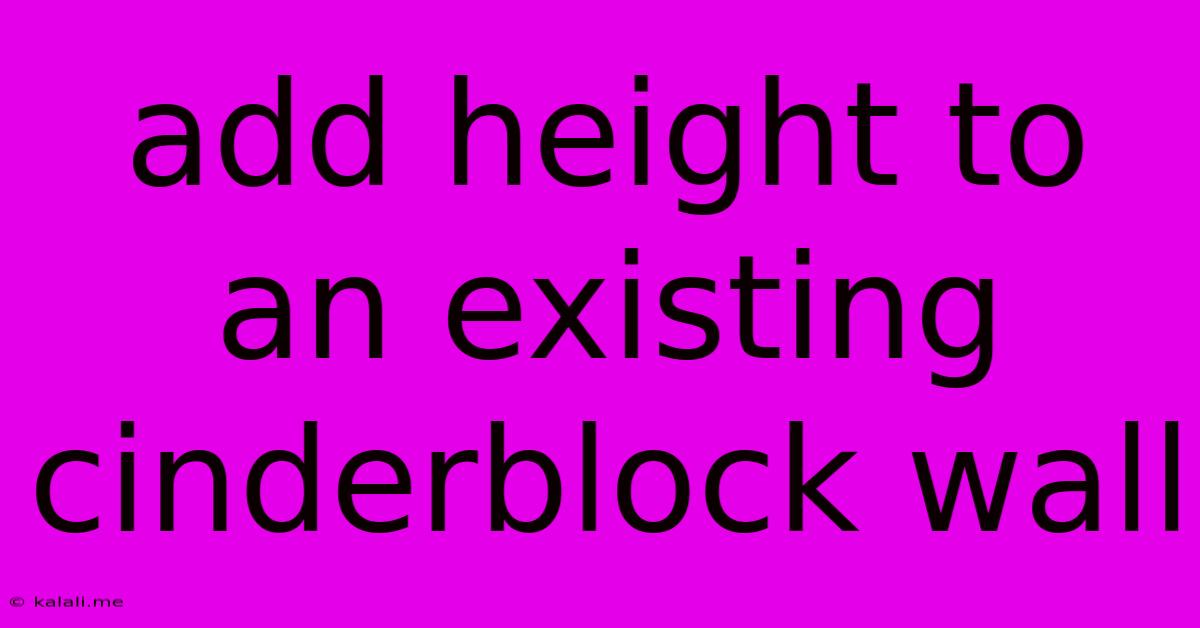Add Height To An Existing Cinderblock Wall
Kalali
Jun 02, 2025 · 3 min read

Table of Contents
Adding Height to an Existing Cinder Block Wall: A Comprehensive Guide
Adding height to an existing cinder block wall might seem daunting, but with careful planning and execution, it's a manageable DIY project. This guide provides a step-by-step process, covering everything from necessary materials to safety precautions, ensuring you achieve a structurally sound and aesthetically pleasing result. Whether you're aiming for a taller privacy fence, a more substantial retaining wall, or simply increasing the height of an existing structure, this guide will equip you with the knowledge you need.
Assessing Your Existing Wall and Planning Your Extension
Before you even think about breaking ground (or laying blocks!), a thorough assessment of your current wall is crucial. This involves:
- Inspecting the foundation: Is the existing foundation strong enough to support the added weight? A weak foundation will compromise the stability of the entire structure. Cracks or settling should be addressed before proceeding. Consider consulting a structural engineer if you're unsure.
- Checking the condition of the blocks: Look for damaged or crumbling blocks. These need to be replaced before adding height.
- Measuring the existing wall: Accurate measurements are paramount for purchasing the correct amount of materials. Note the length, height, and thickness of the wall.
- Determining the desired height increase: How much taller do you want your wall to be? This will dictate the number of blocks you need.
- Planning for drainage: Ensure your design incorporates proper drainage to prevent water damage to the foundation and the wall itself. This might involve adding a gravel base or a drainage system.
- Checking local building codes: Familiarize yourself with local regulations and obtain necessary permits before starting construction.
Gathering the Necessary Materials and Tools
You'll need the following materials:
- Cinder blocks: Purchase high-quality blocks that match the existing wall. Consider the aesthetic implications – you might want to use the same color and texture.
- Mortar mix: Choose a suitable mortar mix for exterior use and follow the manufacturer's instructions for mixing.
- Rebar (optional but recommended): Rebar significantly strengthens the wall, particularly when increasing the height substantially.
- Level: Essential for ensuring straight and level courses.
- Trowel: For spreading and shaping the mortar.
- Bricklayer's hammer: For tapping blocks into place and breaking blocks if needed.
- Safety glasses and gloves: Always prioritize safety.
- Measuring tape: For accurate block placement.
- Line level: To check vertical alignment.
- Wheelbarrow (optional): Helpful for mixing and transporting mortar.
Step-by-Step Guide to Adding Height to a Cinder Block Wall
- Prepare the existing wall: Clean the top of the existing wall thoroughly, removing any loose debris or mortar.
- Lay the first course: Spread a layer of mortar along the top of the existing wall, ensuring even distribution. Carefully place the first course of blocks, using a level to ensure they are aligned and level.
- Add rebar (if using): Insert rebar into the mortar joints for added structural support, ensuring it extends into the existing wall.
- Continue layering: Repeat steps 2 and 3 for each subsequent course, ensuring each layer is level and aligned. Use a line level to check the vertical alignment frequently.
- Allow the mortar to cure: Allow ample time for the mortar to fully cure before applying any further weight or pressure to the wall. Follow the manufacturer's recommendations.
- Finishing touches: Once the mortar is cured, you may wish to point the mortar joints for a more professional finish.
Safety Precautions and Considerations
- Always wear safety glasses and gloves.
- Use caution when working with mortar mix. It can irritate skin and eyes.
- Ensure the foundation is strong enough to support the added weight. If unsure, consult a structural engineer.
- Be aware of weather conditions. Avoid working in extreme heat or cold.
- Never work alone. Have someone assist you, particularly when handling heavy blocks.
Adding height to your cinder block wall is a rewarding project that can significantly enhance your property. By following these steps, prioritizing safety, and carefully planning your project, you can achieve a strong, durable, and visually appealing result. Remember to always consult with professionals if you have any doubts about the structural integrity or building codes.
Latest Posts
Latest Posts
-
How To Change Hebrew Font On Word To Rashi Font
Jun 04, 2025
-
Papers Please Do You Have To Highlight Discrepancies
Jun 04, 2025
-
How To Eliminate Cat Urine Smell From Wood
Jun 04, 2025
-
How Much Cooked Rice Is 1 4 Cup Dry
Jun 04, 2025
-
I M Playing Chess You Re Playing Checkers
Jun 04, 2025
Related Post
Thank you for visiting our website which covers about Add Height To An Existing Cinderblock Wall . We hope the information provided has been useful to you. Feel free to contact us if you have any questions or need further assistance. See you next time and don't miss to bookmark.